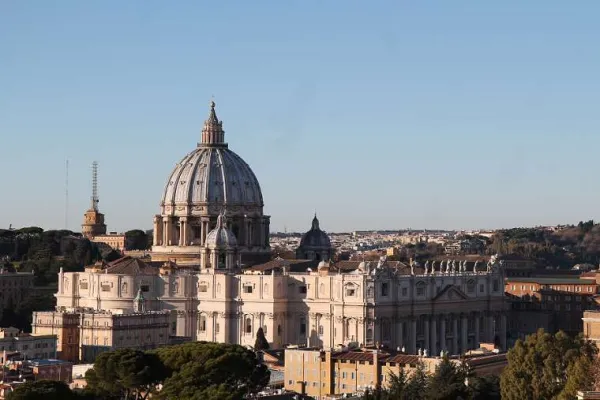
Vatican City, Dec 4, 2019 / 09:30 am (CNA).- The publication date of the new constitution governing the Roman Curia has been delayed again as Pope Francis’ council of cardinals continues to evaluate suggestions to the draft that was given to bishops’ conferences in May.
The now six-member advisory council met at the Vatican Dec. 2-4.
According to a brief Vatican press release Dec. 4, the group of cardinals had continued to receive suggestions on the text of the new apostolic constitution, provisionally titled Praedicate evangelium, until a few days before the start of the latest round of meetings.
The council of cardinals will continue its “reading and evaluation” of the draft at its next meeting, which will take place in February 2020, the Holy See press office stated.
Praedicate evangelium will replace Pastor bonus, the current apostolic constitution on the Roman Curia promulgated by Pope John Paul II on June 28, 1988, and subsequently modified by both popes Benedict and Francis.
The new document is expected to place renewed emphasis on evangelization as the structural priority of the Church’s mission, with some predicting the merger of the Vatican’s Congregation for the Evangelization of Peoples and the Pontifical Council for the Promotion of the New Evangelization into a single larger department.
In June, the secretary of the council, Bishop Marcello Semeraro, said there was a possibility Pope Francis would see a final draft of the document in September, but in September cardinals were still working on incorporating the suggestions submitted by bishops’ conferences and others during the summer.
The new constitution has been the advisory group’s key reform project since its establishment in 2013, one month after Pope Francis’ election.
According to the press release, this week’s meetings focused on two aspects of the draft text: the relationship between the Roman Curia and bishops’ conferences, and the presence of lay men and women in decision-making roles in curial and other Church offices.
The “theological-pastoral bases of these aspects” was also studied.
The Council of Cardinal Advisors is often referred to informally as the “C9,” although there have been only six members for nearly the past year.
The current members – Cardinals Pietro Parolin, Oscar Rodriguez Maradiaga, Reinhard Marx, Sean O’Malley, Giuseppe Bertello, and Oswald Gracias – were all present for the latest gathering, the group’s 32nd round of meetings.
Pope Francis also attended sessions, when not in other audiences and appointments. Bishop Marcello Semeraro, the secretary of the council, was also present at the meetings this week.
Besides discussing the curial constitution, the council heard a report from Cardinal Michael Czerny on October’s Synod of Bishops on the Amazon and some considerations from Cardinal O’Malley on the work of the post-synodal apostolic exhortation.
They also heard from Cardinal Marx on the Church in Germany’s “synodal path” and the topics on which it will focus.
If you value the news and views Catholic World Report provides, please consider donating to support our efforts. Your contribution will help us continue to make CWR available to all readers worldwide for free, without a subscription. Thank you for your generosity!
Click here for more information on donating to CWR. Click here to sign up for our newsletter.



We read that “[t]he new document is expected to place renewed emphasis on evangelization [and that according to a press release] this week’s meetings focused on two aspects of the draft text: the relationship between the Roman Curia and bishops’ conferences […]”. Unmentioned is the challenge of reconciling missionary EVANGELIZATION with domestic and worldly POLITICS. Is this why the fit between the curia and bishops’ conferences has become a worthy sticking point?
In April the draft features of the under-reported curial reform included something like this:
(1) Creation of one merged “super-dicastery” for Evangelization, while the CDF (Congregation for the Doctrine of the Faith) shrinks into a dicastery chorus role (?);
(2) Reform of autonomous departments and pontifical academies nearly all as equivalent dicasteries, and possible creation of a dicastery for Charity, and merger of Culture and Education (subsumed?);
(3) Decentralization from Rome even as Evangelization, and possibly Charity AND especially the SECRETARIAT OF STATE (Cardinal Parolin) are ascendant;
(4) themes, overall, from Evangelii Gaudium, Laudato Si, and Amoris Laetitia.
So, one wonders about the surely unresolved TENSION between (a) evangelization (CDF demoted?) and (b) politics (Secretariat of State pre-eminent)—-and, for example, the already disastrous CHINA DEAL (with Bishop Sorondo, Pontifical Academy of Social Science, earlier tutoring that Communist China is a model of the Church’s social teaching!!!), plus the “diversity of [equivalent] religions” PREFACE to humanitarian relations with Islam (the Joint Declaration, Feb. 2019), plus the free-form approach to “SYNODALITY” exercised by Pachamama/ Amazonia, and Germania in coming years (both out of sync with the key anchor points in the International Theological Commission’s “Synodality in the Life and Mission of the Church,” March 2018).
To this admittedly uninformed and very-outside lay reader, there still is reason to at least speculate why responsible members of some bishops’ conferences might tender a few “suggestions” to the C-6 inner circle…